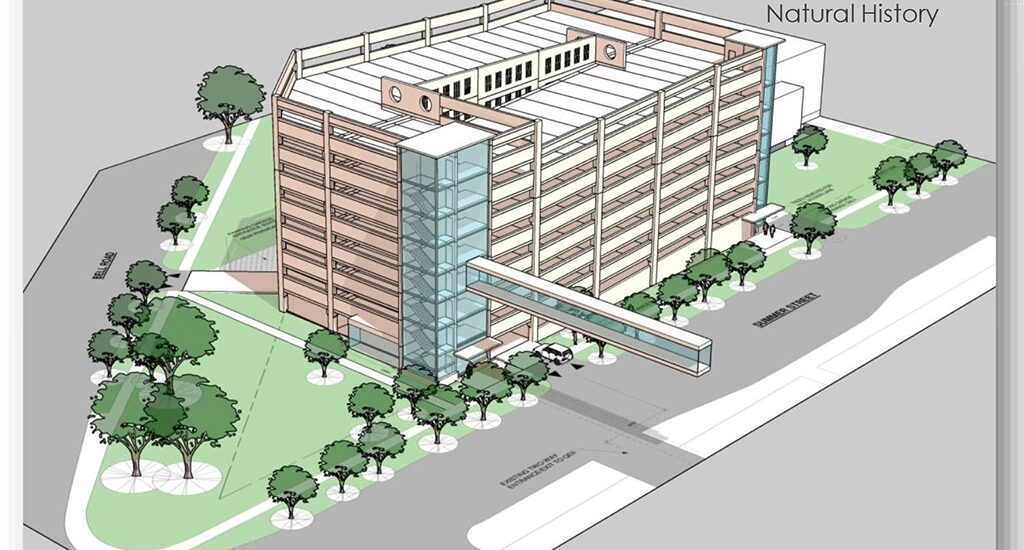For Immediate Release
Media Advisory – Sept 27, 2020

KJIPUKTUK (Halifax) Friends of Halifax Common (FHC) are calling on the Halifax Regional Municipal and Nova Scotia governments to scrap the $30 million dollar, 500-stall, 8-storey parking garage planned for the Nova Scotia Museum property as part of the proposed $2 billion dollar QEII hospital expansion.
The province has recently come to the city with yet a fourth version of the parking garage and pedway over Summer Street, flipping the orientation and chewing up more of Halifax Common’s green space.
“It is time for the Mayor and Council to say to the Province that no parking garage is needed at all, and it is time to say that HRM’s policies are for no more loss of green space on the Common,” said Howard Epstein, FHC director. “Finally, Council needs to remind the Province that under section 213 of the HRM Charter it has pledged to take HRM land-use policies into consideration.” Epstein is a former City Councillor, 5-term MLA and planning professor at Dalhousie’s Schulich School of Law.
FHC maintains that the QEII hospital re-development should be restricted to Halifax Common lands already assembled by the Nova Scotia Health Authority. The Authority already plans additional underground parking under the new hospital buildings and a second 1000-stall parking garage on the former CBC-TV site. 20-25% of the Halifax Common is used for parking, the majority by the Health Authority.
In February, FHC presented a ~3,000 signature electronic petition to City Hall and to the NS Legislature. The signatories opposed plans for a 7-storey parking garage and steam plant on the south side of the NS Museum. A second HRM Council “compromise” plan with the Province to instead build these on a western portion of Summer Street failed. Now the third 8-storey parking garage option needs more easement and a new orientation.
In a 2008 Memorandum of Understanding (MOU) about land swaps between HRM and the Province it was agreed ‘as a condition of sale, (that HRM and the Province) approve the key Urban Design Principles and Site Planning Guidelines’ and Collaborative Planning. So far the Province is not following that or any of the other conditions outlined in the MOU.
FHC believes that both levels of government need to work together and pursue better options to solve parking problems at the hospital. These could include park and ride, shuttle buses, employee e-passes, and car share arrangements.
It is obvious that Lloyd Hines, NS’s Minister of Transportation and Infrastructure Renewal does not understand what a bad idea the new parking garage is. We are 10 years from a climate catastrophe, and the minister is fiddling while the city burns. The Mayor and Council should stop dancing to the tune.
~30~
Media contact: Peggy Cameron p.cameron@ns.sympatico.ca




A Public Health Fail, a waste of money, AND needless destruction of public green space.
I am appalled that the very first building in the NSHA QEII Next Generation Project should be required to employ an obsolete parking technology that will require users (patients, their families, NSHA employees, contractors) to cumulatively and unnecessarily spend over a hundred thousand wasted hours a year for the next thirty or fifty years breathing a toxic stew of car exhaust gases mixed with airborne tire and brake dust.
As I’ve commented earlier elsewhere, the original Dept of Transportation and Infrastructure Renewal’s RFP arbitrarily and sneakily ruled out any proposals that might use automated (robotic valet) parking technology. Senior DTIR management overruled NS Lands staff recommendations without serious consideration (reasons later cited by DTIR are biased personal opinions and BS).
Such automated (robotic) valet parking systems offer parkade users a more efficient, much more accessible, faster, safer, greener, healthier experience in a smaller structure that could sit on the existing hospital surface parking lot off Robie St. next to the Veterans’ Memorial Building. One leading US supplier stated to me that they would have made a proposal with initial construction costing significantly less than the $30 million bid DTIR accepted. It would have lower annual operating costs.
The ~$30,000,000 dollar price accepted by the NS Government was a short-sighted “convenient-to-DTIR management”, “ignore-the-project’s-externalities” decision. We Nova Scotians will be overpaying for that bad decision for up to half a century with its high price in Nova Scotians’ health, in climate-damaging CO2 emissions, and civic environmental degradation.
It’s time for a total rethink. It is Covid-time, Climate-disaster-time, budget time, health and wellness time, … Not business-as-usual time in the NS road-builders clubhouse.